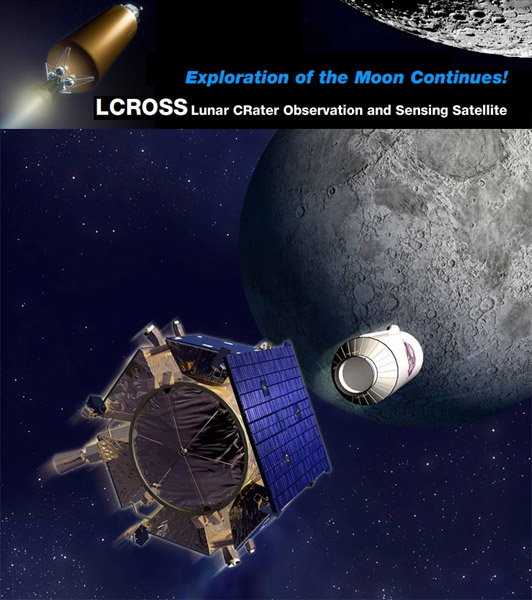March 20, 2008
A Step Closer To Solving the Riddle of Lunar Water

LCROSS website images montaged by Mark Zambelli
After the hint and confirmation of the detection of hydrogen at the Lunar poles by Clementine and Lunar Prospector (respectively) there has been a determination to seek out answers as to whether or not this signature of hydrogen is truly from water-ice or hydrogen hiding in permanently shadowed craters at the Moon's poles. Lunar Prospector's impact failed to generate the science needed to clinch the deal and so the LCROSS mission will step-up and take the necessary measures to finally lay the question to rest. To be launched later this year on the same rocket that carries the Lunar Reconnaissance Orbiter (LRO), this new low-cost mission will spend the better part of three months swinging past the Earth in a unique orbit designed not only to give LRO a chance to get to the Moon first and to return at least a months worth of data from Lunar orbit, but also to increase the impacting booster stage's momentum to maximise the energy involved in creating a plume of debris (hopefully visible from earth in 10" - 12" and larger amateur telescopes) that LCROSS' sensor-laden shepherding-craft will fly through for a few minutes before it too creates a new crater. The majority of the science will be gained in just the last 10 minutes of this brave new undertaking and that data will be eagerly awaited for its implications for humanity's return to the Moon.
Mark Zambelli
Related Links
Rükl Plate: 73
Lunar Pathfinder Getting Ready
See the main LCROSS mission site for a full run-down of all the information involved. Article outlining Lunar Prospector's results
Note: this LPOD was contributed by a Wikispaces member when Chuck Wood was attending the March 2008 Lunar & Planetary Science Conference.
Yesterday's LPOD: Arthur Clarke
Tomorrow's LPOD: A Global Eclipse
COMMENTS
(1) What an exciting mission! I checked the LCROSS site and the FAQs. Has a crater been selected for the impact site? I couldn't find anything on that. I assume the impactor will not carry any cameras or other instrumentation. (??)
--Bill
(2) Yes it is exciting for sure. We in the UK had a recent Sky at Night program that went into some depth about this mission and I can't recall the lead scientists mentioning an exact target crater yet. I can only assume that the final selection may take place during the main-phase of the mission. As far as I can tell the impacting booster-stage won't be carrying cameras etc... with the sensing probe following very closely behind, the images are going to be taken from that craft so having cameras on the booster may just be redundant. I did hear though that one of the many imaging sensors (with a near-IR filter) on the shepherd-craft will be able to 'clearly' see the surface of the shadowed crater floor before and during the impact... this would be needed as the plume will only become visible once it has risen above the rim and catches sunlight.
Mark
(3) Chuck, Jim, Mark...
I have a suggestion for the "Lunar Places" page. You could add the "Inconstant Moon" website at www.inconstantmoon.com I think the site is very professional and offers a lot of useful information.
Apologies for putting my message here, but I couldn't figure out how to leave a message anywhere else.
--Bill
COMMENTS?
Register, Log in, and join in the comments.



